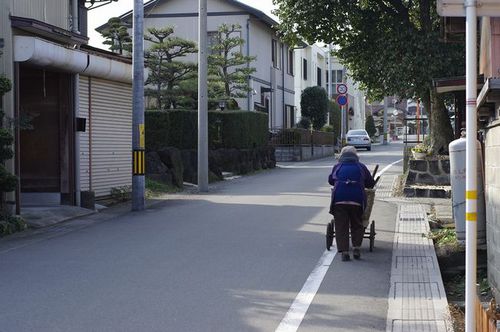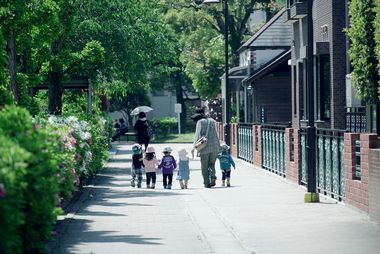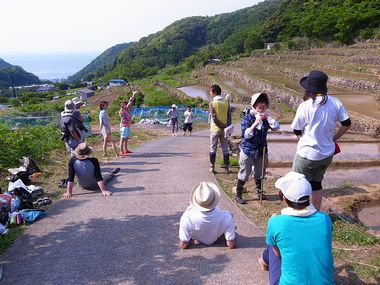June 30, 2014
Depopulation of Society: Debate in Japan, One of the World's First Countries to Face the Issues
Keywords: Aging Society Newsletter Steady-State Economy
JFS Newsletter No.142 (June 2014)

Image by B.B Some Rights Reserved.
Issues surrounding depopulation have been hotly debated in Japan in recent years. The country's population almost tripled over the course of a hundred years and peaked in 2008. By October 2013, however, it had dropped back to 127.29 million, a decrease of approximately 800,000 people. If the population were to continue decreasing at this pace, we are told, it would drop to one-third the current number over the next 100 years.
If this trend continues, population decline and aging will lead to a decrease in the workforce, shrinkage in production and consumption, and a further softening of the economy. As a result, Japan will become weaker as a nation, and may not be able to maintain its position in the world. This is the tone of some of the discussions these days.
The Japanese government has repeatedly expressed its intent to make intense efforts to raise the birth rate, and in fact has taken various measures, including providing support to families raising children. None of the measures, however, has had a major impact so far. (Countries including France and Sweden budget 3 percent of gross domestic product to support families raising children, while in Japan the figure is only around 1 percent. Some people regard this fact as the reason for the limited effect Japan's measures to stem the falling birth rate.)
In these circumstances, there is a move afoot to consider not just specific policies, but also the long-term national strategy. What Japan should become in the future?
In January 2014, the "Choosing the Future" Committee was established under the Council on Economic and Fiscal Policy, which is chaired by the Prime Minister. The committee's statement of purpose says, "Over the next five decades, the circumstances facing Japan, including the global economy and population, are expected to change significantly. Some say that Japan's share the global economy will decline under these circumstances. On the other hand, policy efforts and the will of the people can significantly change the situation. In other words, we can choose our future."
The basic policy reads, "If we continue on this path, it is likely that Japan will be further depopulated and aged, the Japanese economy will shrink, and national strength will eventually weaken. This committee is to hold discussions in order to change these possible future scenarios."
Documents distributed at the third meeting of the committee, on February 24, stated that, "If the birth rate remains unchanged, the population will decrease to approximately 87 million in 2060 and to approximately 43 million in 2110. However, if the total fertility rate rises to 2.07 in 2030, then the population will be approximately 98 million in 2060 and approximately 91 million in 2110. Furthermore, if Japan accepts 0.2 million immigrants annually, it can maintain a population of approximately 110 million."
According to future estimates of the population aged 20 to 74 years, which was defined as the new working-age population, "The new working-age population was approximately 90 million in 2012. If the birth rate remains unchanged, the new working-age population will decrease to approximately 52 million in 2060 and approximately 26 million in 2110. However, the new working-age population will be approximately 57 million if the birth rate recovers to 2.07, and approximately 72 million if immigrants are included."
In a May 13 meeting of the committee, the target of "keeping a stable demographic structure with a population of around 100 million in 50 years" was proposed. To this end, the total fertility rate must be raised to 2.07 by around 2030. But in reality, the rate dropped to below 2.0 in 1975, and marked the lowest at 1.26 in 2005. Then the rate remained unchanged for several years, and rose slightly to 1.43 in 2013, the first time in the 17 years since 1996.

Image by peace6x Some Rights Reserved.
It can be seen that, considering Japan's past approaches and achievements, the target of the fertility rate needed to maintain the population of 100 million seems to be so high that it almost sounds like wishful thinking. Furthermore, since Japan has not positively accepted immigrants so far, there is considerable doubt whether such a country can accept 200,000 immigrants every year, or four to six times the current number. And if this immigration policy works well, one in every five workers in Japan will be foreign nationals. Is this really realistic?
In addition, immigrants also get old and retire, and then need pensions and other social welfare services. Japan cannot force them to return to their countries for the reason that they are not in the labor force anymore. As a result, future generations of Japanese will need to bear the burden of pensions for immigrants, and so on. In light of these situations, the target of "keeping the population of 100 million people" itself seems quite difficult to attain.
Likewise, at the end of March, the Japanese Ministry of Land, Infrastructure, Transport and Tourism (MLIT) announced its projections: "Japan's declining population will make about 60 percent of the land area unpopulated by 2050." The projections were based on the calculation of demographic change in each of about 380,000 blocks (each with an area of one square kilometer), matching Japan's total land area of 380,000 square kilometers. According to the projections, 20 percent of inhabited blocks will be unpopulated, and in 60 percent of the blocks, the population will fall a half by 2050. The ratio of unpopulated blocks is expected to rise from the current 53 percent to 62 percent.
Based on the projections, MLIT announced the outline of a "grand design," a basic policy for future national development to prepare for the shrinking population. This policy aims to develop a new grand design of the nation on the basis of six current trends: rapid population decline, declining birth rate, and an aging society; expanding globalization; imminent massive disasters and aging infrastructure; the constraints of food, water, and energy, and global environmental issues; and drastic advances in information and communications technologies, and technical innovations.
MLIT, however, has listed the opening of the Linear Chuo Shinkansen -- a maglev train line that links big cities -- as the top priority of specific promotion measures for the policy. MLIT says that by doing so, Japan will aim to establish the world's greatest mega-region, with a view to strengthening its international competitiveness. From MLIT's standpoint, this strategy is possible. But in order to address the declining population, an inter-ministerial issue, we think that the relevant ministries and agencies need to cooperate beyond each of their jurisdictions and draw up comprehensive strategies that defy boundaries among ministries and agencies.
The national government is not the only one debating the population issue. A shocking and detailed report titled "Municipalities at Risk of Vanishing" released on May 8, 2014 created a fuss nationwide. It was by the Japan Policy Council's (JPC's) study group on depopulation. The JPC was established by business and union leaders and scholars to advance proposals to create a new Japan and stimulate a national debate based on the citizens' perspective.
Normally, the total fertility rate (average number of children a woman will bear over her lifetime) is used as an index for population projections. However, if the number of women of child-bearing age declines, even a rise in the fertility rate would not lead to an increase in the actual number of babies born. Giving considerable attention to the fact that women, especially young ones who have a chance to bear children in the future, are flowing to urban from rural areas, the JPC identified the municipalities whose population of young women (aged 20 to 39) would decrease to less than half of the current level in 30-years time, and called them "municipalities at risk of vanishing."
According to the JPC, women in the 20 to 39 age bracket account for 95 percent of Japan's total fertility rate of 1.41 in the year 2012, and as long as the number of women in this age bracket continues to decline, the "reproductive potential" of the population will continue to drop, thus no stopping the decrease of the total population.
The result of JPC's analysis shows that the number of municipalities categorized as municipalities at risk of vanishing amounts to 896, accounting for 49.8 percent of the total number of municipalities in the country. One village is projected to have only eight women aged 20 to 39 by 2040. In the municipality, which was identified as the worst in terms of the decline rate in the number of young women, the mayor was forced to explain the situation and established an emergency task force. These repercussions caused by JPC's data were called the "Masuda shock," named after Hiroya Masuda, the chairman of JPC's study group and the former Minister of Internal Affairs and Communications.
The proposal, entitled "Strategy to Stop the Declining Birthrate and Revitalize Local Areas," prepared by the study group, includes the following guidelines for strategies: creating a society and environment conducive for young people to get married, give birth to babies, and raise a family; and turning around "the flow of young human resources" from rural to urban areas so as to stop the situation of excess concentration of population in the Tokyo metropolitan area. Their basic stance described in the proposal is that the people need a shared awareness of these issues, and at the same time, to proceed with effective measures by triggering a national debate.

Image by na0905 Some Rights Reserved.
As such, in Japan, the government and private sector have finally started to face the reality of depopulation. Currently, the tone of discussion, particularly at the national level, goes like this: "We should accept the reality of depopulation and make efforts to stop the decline instead of trying to change the structure of society and the economy."
What seems to be important for Japan, however, is to consider how we should create a mechanism of a society and economy adapting to the declining population, and develop the strategy we need to live sustainably and happily, even if the population declines.
Japan is farther ahead than any country in the world in the aging of society and with a declining population. These issues, however, are expected to be big global issues for the future. Can Japan tackle these difficult challenges by applying new, out-of-the-box approaches? What kinds of efforts are being initiated locally in Japan? We will continue to keep you updated on these issues. Stay tuned!
Written by Kaori Iwashita and Junko Edahiro
Related
"JFS Newsletter"
- 'Good Companies in Japan' (Article No.4): 'Eightfold Satisfaction' Management for Everyone's Happiness
- "Nai-Mono-Wa-Nai": Ama Town's Concept of Sufficiency and Message to the World
- 'Yumekaze' Wind Turbine Project Connects Metro Consumers and Regional Producers: Seikatsu Club Consumers' Co-operative
- Shaping Japan's Energy toward 2050 Participating in the Round Table for Studying Energy Situations
- 'Good Companies in Japan' (Article No.3): Seeking Ways to Develop Societal Contribution along with Core Businesses


